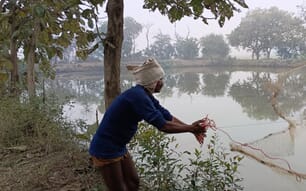Using grass carp to remove invasive weeds from waterways is an effective biological control, but it always comes at a cost - large numbers of fish are required, they remain in the waterway until they die and they indiscriminately remove all plants present, including desirable non-target species.
The study, carried out for MPI by National Institute of Water and Atmospheric Research (NIWA) scientists, found that if an unwanted aquatic weed species is found at an early enough stage, there is potential to eradicate it using fish contained in a pen and applied to the area of weed infestation.
Once the target invasive weed has been eradicated, the fish can be safely removed along with their enclosure.
MPI Senior Science Adviser Andrew Bell says the recent successful trial was carried out at Waikatos Lake Karapiro treating the widespread pest weed hornwort.
This novel approach was so effective that MPI now has it in the toolbox for use should the unwanted organism hornwort be found in South Island lakes, Dr Bell says.
Local iwi supported the project and are interested in the results and the potential to use grass carp as a biological control tool. They recognise that grass carp may have a role not only in biosecurity responses when hornwort occurs in new locations, but also as a potential invasive weed management tool in hydro dams and other sites in their areas.
Grass carp have been used successfully for the control of large infestations of other invasive weeds in New Zealand lakes since they were introduced in the late 1960s from Malaysia. They are a natural aquatic weed controller and are unable to breed in the wild in New Zealand, unlike koi carp, which breed well and have become a pest species.
NIWA principal scientist aquatic plants, Dr John Clayton says as part of the study, the team built six large enclosures 2.5 metres deep and 6 metres wide, and placed them within hornwort beds in Lake Karapiro.
The cages contained different numbers of fish in order to establish the most effective stocking rate required for rapid removal of nuisance weed within the enclosed area, Dr Clayton says.
Three to five fish per enclosure were found to be effective and very fast, with weed in the enclosed areas removed in nine weeks.
Designing enclosures that were escape-proof was particularly challenging for the NIWA team, but Dr Clayton says the end result was an innovative design that had animal ethics committee approval.
Caged Grass Carp Promising for Waterweed Control
NEW ZEALAND - A Ministry for Primary Industries-funded trial has shown that grass carp (a weed eating fish) in enclosures could be used to eradicate early infestations of aquatic weeds, doing away with the need to release large numbers of fish throughout a lake, and preventing damage to other plant species in the water.
by Lucy Towers


